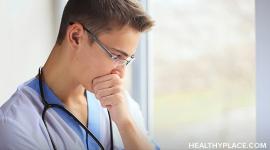Pain of Depression: Physical Symptoms of Depression
Depression is a mental illness known as a mood disorder, so some people think the only effects of depression are on mood. This, however, is not the case. Depression is linked to many physical symptoms including insomnia, lack of energy and loss of interest in sex. Physical pain from depression is also widely recognized with up to half of all people with depression reporting physical pain. In a study of 25,000 patients, 50% of depressed patients reported unexplained, physical symptoms of depression.1
The physical pain of depression should be a major concern for doctors, as continuing pain reduces the chances for a successful recovery from depression and increases the possible risk of suicide.
Does Depression Cause Pain?
Just as depression is thought to be related to specific nerve pathways in the brain, so too is the transmission of the sensation of pain. It is thought that the brain chemicals serotonin and norepinephrine that travel down the spinal cord from the brain to the rest of the body relate to the feelings of pain. Serotonin and norepinephrine are also widely thought to be involved in mood disorders, so it's likely that dysfunction in this system would affect both depression and pain.
Pain and Depression
According to Harvard Medical School, "Pain is depressing, and depression causes and intensifies pain." People with chronic pain have three times the risk of developing a psychiatric disorder like depression, and those with depression have three times the risk of developing chronic pain.2
Serious, painful medical conditions are known to complicate and increase the likelihood of depression. Conditions commonly seen co-existing with depression include:
- Chronic fatigue syndrome
- Lupus
- Heart disease
- Anxiety / PTSD (read about: Anxiety and Depression)
- Cancer
- Alzheimer's
- HIV / AIDS
Research has shown that when depression occurs with another severe illness, depression symptoms tend to be more severe. However, treating the depression can help both the mental illness and the co-existing medical condition.3
In fact, when a person seeks treatment for depression, often their mood isn't their chief complaint. Often they are there because of physical symptoms and it's up to the doctor to make the link between depression and pain.

Physical Symptoms of Depression
Depression can cause many physical symptoms, some related directly to pain and others not. General physical symptoms of depression include:
- Oversleeping / undersleeping
- Chronic fatigue, tiredness
- Increase or decrease in appetite
- Loss of sex drive
- Slowed thinking and movements
- Memory difficulties, inability to make decisions
In addition to the above physical symptoms of depression, physical pain from depression can include the following:
- Headaches, migraines
- Abdominal pain
- Gastrointestinal problems
- Muscle and joint pain, often in the back
- Arthritis
Now that you better understand the physical symptoms of depression and the "pain of depression", did you know depression also causes cognitive dysfunction; problems with thinking, memory and more? Read about them.
APA Reference
Tracy, N.
(2021, December 30). Pain of Depression: Physical Symptoms of Depression, HealthyPlace. Retrieved
on 2026, January 9 from https://www.healthyplace.com/depression/symptoms/pain-of-depression-physical-symptoms-of-depression


